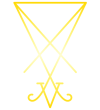Basic Guidelines for Covens
The purpose of the coven is strength in numbers. The combined soul/mind power of the members can accomplish much more than one person working alone. A coven provides companionship, mutual enjoyment of the practices, camaraderie, and functions like a close-knit family. A working performed by the group will usually succeed remarkably, whereas one performed alone may only yield moderate success. All Temple of Zeus covens exist for the purpose of spiritual warfare. Each coven works directly with a Patron Demon who guides and instructs the group according to the wishes of Zeus. The coven must operate in absolute secrecy.
The word "coven" is derived from the Latin "conventus," meaning "gathering," "assembly," or "to convene." It shares roots with "convention" and "covenant."
The coven itself becomes a powerful unit. The stronger the minds and souls of the individual members, the more powerful the coven as a whole. Over time, through consistent workings, the coven develops a strong aura of energy from which individual members can draw to supplement their own power. The coven becomes an energy bank. This is only possible with regular meetings and rituals in which all members work together as a unit. Consistency is always key in building and sustaining spiritual energy.
Just as individuals grow stronger through consistent yoga and meditation, so too does a coven. Consistent effort builds energy, sharpens focus, and strengthens the coven as a whole.
The structure and requirements of a coven:
- A coven consists of 13 members or less. These include the High Priest/ess, who leads the group. When the number exceeds 13, a new coven is formed, splitting away from the original. This is based on the 13 full moons in a lunar year and the 13 chakras of the soul.
- Every coven must have a Patron Demon, usually the High Priest/ess's Guardian Demon. This Demon must be asked and must agree to serve as the Patron.
- The coven should have a regular meeting place. This can be outdoors or in a member’s home, preferably with a dedicated room functioning as a temple, designed, consecrated, and dedicated to Zeus.
- Traditionally, there should be at least three miles between the meeting points of individual covens. The old custom of "territorial rights" applies here.
- The coven should have a hierarchy.
- Each new member must undergo an initiation ritual, swear allegiance to Zeus, and take a binding oath of absolute secrecy.
- Before initiation, each new member must have already performed their dedication ritual to Zeus. This dedication can be done under the coven’s supervision, if the initiate is comfortable with that. All members should feel a strong kinship and harmony with one another, as compatibility is essential. Once the oath is taken, it is permanent.
- Each coven should have a magickal name. This can include the name of the Patron Demon and should be Zevic in nature.
- Each coven should have its own insignia, to be sewn onto every member’s robe. This can be the sigil of the Patron Demon.
The Esbat
Ideally, the coven should meet during the full moon cycle (Esbat). The full moon favors astral energies, increasing the success of workings. The Moon rules the female side of the soul, which provides the energy necessary for any working. The full moon amplifies this effect.
Regular monthly meetings should be held, with a special rite said unto Zeus. Afterwards, matters of importance are discussed, and the group works on developing their powers together. This can include telekinesis, where members attempt to move or levitate an object together. The type of working and specific exercises used are up to the coven as a whole. It is important to agree, but time should not be wasted on indecision.
If any member is in need, the entire coven comes together to perform a working on their behalf. In time, the bond between members should surpass even that of blood relatives, as this connection forms at the soul level through joint workings.
The Sabbat
On Zevic Holidays (Sabbats), the coven gathers to celebrate. Greater Sabbats are for both celebration and serious workings and dedications. Each Sabbat aligns with powerful astral energies. This alignment is why the ancients built monuments like Stonehenge, which were attuned to the sun and seasonal cycles. It is all based on science.
The earth's energies and its relationship to other celestial bodies during these times are highly favorable for spiritual workings. Celebrations occur after important rituals. Misinformation has led some to think Sabbats are only for feasting, but in truth, these dates are essential for accomplishing significant spiritual work that may not be possible at other times. They hold powerful, often sacred significance.
Though speculative, the word "Sabbat" closely resembles the Sanskrit word "Sabda," which means "sound." Harmonized group vibration is far more potent than that of an individual. Many Demon names, and even the name "Satan," which means "Truth," have roots in Sanskrit.
The coven’s highest purpose is to serve as a dedicated medium for Zeus, carrying out His work, which usually involves spiritual warfare. The Patron Demon gives the orders. Utmost secrecy is required. These workings traditionally occur during the Esbats. Afterward, both Greater Sabbats and Esbats involve feasting and celebration. Members are encouraged to bring food and drink. Meetings should always be a positive experience for all.
The second-in-command under the High Priest/ess is called the officer or executor of the coven. This person manages membership, sends out information about meetings, and communicates what to wear or bring: whether food, music, or ritual items. If the High Priest/ess is absent, the officer takes their place.
What is needed for a coven celebration:
The primary focus of the coven is working as a unit to achieve magickal feats that one person alone may not accomplish. The following items are ideal but not absolutely necessary. If the ritual items prove too difficult to obtain, this will not prevent you from functioning as a coven. What matters most is that members meet regularly and work together consistently.
Suggested items for celebration and ritual:
One or more small drums (e.g., bongos) to establish rhythm. Rhythm and dance are traditional ways to raise energy.
Optional instruments: tambourines, recorders, panpipes, flutes, rattles: used during circle dances to raise power. Dancing is often done in a line, snake-like, led by the High Priest/ess, making S-curves and turns. After the rite, instruments may be played, or modern music (e.g., metal or other lively genres) may be played over speakers.
A suitable altar and tools. These may belong to the High Priest/ess or be designated for the coven’s use. A group chalice is needed, filled with wine or another beverage. All members will sip from it during ritual. These props help create the desired atmosphere, though they are not essential for soul and mind-based workings.
For teens and others with limitations, props are not necessary. The essentials are dedication to Zeus and regular meetings. Coming together and focusing the mind on a specific working are the core requirements for a coven.

 አማርኛ
አማርኛ العربية
العربية বাংলা
বাংলা Български
Български 中文
中文 Čeština
Čeština Dansk
Dansk Deutsch
Deutsch Eesti
Eesti Ελληνικά
Ελληνικά Español
Español Français
Français हिन्दी
हिन्दी Hrvatski
Hrvatski IsiZulu
IsiZulu Italiano
Italiano 日本語
日本語 Kiswahili
Kiswahili Magyar
Magyar Македонски
Македонски नेपाली
नेपाली Nederlands
Nederlands فارسی
فارسی Polski
Polski Português
Português Română
Română Русский
Русский Slovenščina
Slovenščina Suomi
Suomi Svenska
Svenska Tagalog
Tagalog Türkçe
Türkçe